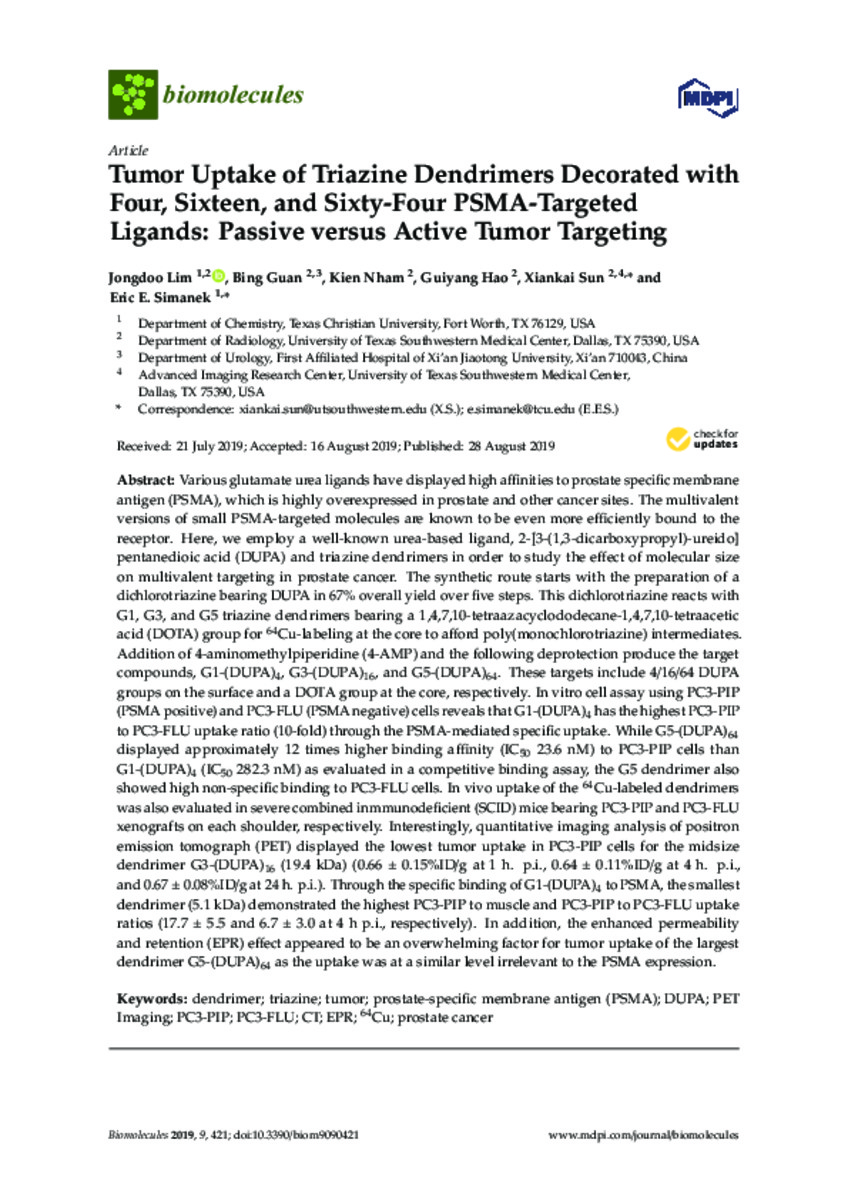Tumor Uptake of Triazine Dendrimers Decorated with Four, Sixteen, and Sixty-Four PSMA-Targeted Ligands: Passive versus Active Tumor TargetingShow full item record
| Title | Tumor Uptake of Triazine Dendrimers Decorated with Four, Sixteen, and Sixty-Four PSMA-Targeted Ligands: Passive versus Active Tumor Targeting |
|---|---|
| Author | Lim, Jongdoo; Guan, Bing; Nham, Kien; Hao, Guiyang; Sun, Xiankai; Simanek, Eric E. |
| Date | 2019-08-28 |
| Abstract | Various glutamate urea ligands have displayed high affinities to prostate specific membrane antigen (PSMA), which is highly overexpressed in prostate and other cancer sites. The multivalent versions of small PSMA-targeted molecules are known to be even more efficiently bound to the receptor. Here, we employ a well-known urea-based ligand, 2-[3-(1,3-dicarboxypropyl)-ureido] pentanedioic acid (DUPA) and triazine dendrimers in order to study the effect of molecular size on multivalent targeting in prostate cancer. The synthetic route starts with the preparation of a dichlorotriazine bearing DUPA in 67% overall yield over five steps. This dichlorotriazine reacts with G1, G3, and G5 triazine dendrimers bearing a 1,4,7,10-tetraazacyclododecane-1,4,7,10-tetraacetic acid (DOTA) group for 64Cu-labeling at the core to afford poly(monochlorotriazine) intermediates. Addition of 4-aminomethylpiperidine (4-AMP) and the following deprotection produce the target compounds, G1-(DUPA)4, G3-(DUPA)16, and G5-(DUPA)64. These targets include 4/16/64 DUPA groups on the surface and a DOTA group at the core, respectively. In vitro cell assay using PC3-PIP (PSMA positive) and PC3-FLU (PSMA negative) cells reveals that G1-(DUPA)4 has the highest PC3-PIP to PC3-FLU uptake ratio (10-fold) through the PSMA-mediated specific uptake. While G5-(DUPA)64 displayed approximately 12 times higher binding affinity (IC50 23.6 nM) to PC3-PIP cells than G1-(DUPA)4 (IC50 282.3 nM) as evaluated in a competitive binding assay, the G5 dendrimer also showed high non-specific binding to PC3-FLU cells. In vivo uptake of the 64Cu-labeled dendrimers was also evaluated in severe combined inmmunodeficient (SCID) mice bearing PC3-PIP and PC3-FLU xenografts on each shoulder, respectively. Interestingly, quantitative imaging analysis of positron emission tomograph (PET) displayed the lowest tumor uptake in PC3-PIP cells for the midsize dendrimer G3-(DUPA)16 (19.4 kDa) (0.66 ± 0.15%ID/g at 1 h. p.i., 0.64 ± 0.11%ID/g at 4 h. p.i., and 0.67 ± 0.08%ID/g at 24 h. p.i.). Through the specific binding of G1-(DUPA)4 to PSMA, the smallest dendrimer (5.1 kDa) demonstrated the highest PC3-PIP to muscle and PC3-PIP to PC3-FLU uptake ratios (17.7 ± 5.5 and 6.7 ± 3.0 at 4 h p.i., respectively). In addition, the enhanced permeability and retention (EPR) effect appeared to be an overwhelming factor for tumor uptake of the largest dendrimer G5-(DUPA)64 as the uptake was at a similar level irrelevant to the PSMA expression. |
| Link | https://doi.org/10.3390/biom9090421
https://repository.tcu.edu/handle/116099117/35810 https://www.mdpi.com/2218-273X/9/9/421 |
| Department | Chemistry and Biochemistry |
| Subject | dendrimer
triazine tumor prostate-specific membrane antigen (PSMA) DUPA PET Imaging PC3-PIP PC3-FLU CT EPR 64Cu prostate cancer |
Files in this item
This item appears in the following Collection(s)
- Research Publications [1008]
Related items
Showing a few items related by title, author, creator and subject.
-
Differences in predictions of ODE models of tumor growth: A cautionary example
Murphy, Hope; Jaafari, Hana; Dobrovolny, Hana M. (2016-02-26)Background: While mathematical models are often used to predict progression of cancer and treatment outcomes, there is still uncertainty over how to best model tumor growth. Seven ordinary differential equation (ODE) models ... -
A Retrospective Study: Tumor Recurrence and Overall Survival in HCC Patients Treated with Y-90 Therapy
Thompson, Mallory (5/1/2023)Research Question: In patients with unresectable hepatocellular carcinoma (HCC), what is the tumor recurrence and overall survival in patients that were treated with Y-90 SIR-spheres® compared with Y-90 TheraSphere™ ... -
Bolivian medicinal herbs as source of leads for anti-tumor and anti-HIV drugs
Miao, Wenfang (2000)Natural products have played and continue to play an invaluable role in the drug discovery process related to all disease types and, in particular, in the areas of cancer and infectious diseases. Over 1000 years the Kallawaya ...
© TCU Library 2015 | Contact Special Collections |
HTML Sitemap






